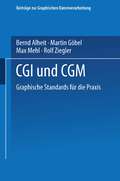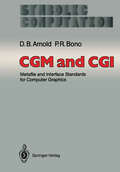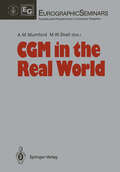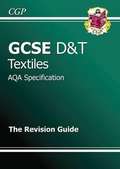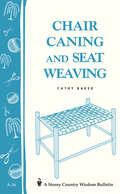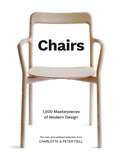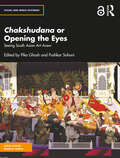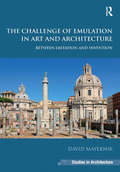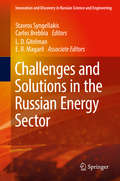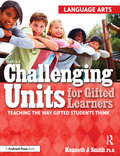- Table View
- List View
CGI und CGM: Graphische Standards für die Praxis (Beiträge zur Graphischen Datenverarbeitung)
by Bernd Alheit Martin Göbel Max Mehl Rolf ZieglerDieses Buch behandelt zwei internationale Standards der Graphischen Datenverarbeitung (Computer Graphics). CGI (Computer Graphics Interface) definiert eine Schnittstelle zu interaktiven graphischen Ausgabegeräten. CGM (Computer Graphics Metafile) beschreibt die Schnittstelle, die zur Bilddefinition auf Speichermedien oder zur Übertragung graphischer Daten zwischen verschiedenen Graphikpaketen benutzt wird. Das Buch gibt einen umfassenden Einblick in die Konzepte und Methoden dieser beiden Geräteschnittstellen. Die Einordnung in die Vielzahl weiterer Standards der Graphischen Datenverarbeitung wurde besonders berücksichtigt. Dieses Buch ist die erste umfangreiche Beschreibung dieses Themas in deutscher Sprache. Da alle graphischen Standards und die Sekundärliteratur nur in englischer Sprache vorliegen, dient es dazu, dem Leser einen vereinfachten Zugang zu den Themenbereichen zu geben. Das Ziel dieses Buches ist, dem Neuling im Bereich der graphischen Standards einen umfassenden und dennoch kompakten Einstieg zu vermitteln. Erfahrenere Leser erhalten detaillierte Informationen. Implementierer dieser Standards können die über die Beschreibung der Standards hinausgehenden Bemerkungen nutzen.
CGM and CGI: Metafile and Interface Standards for Computer Graphics (Symbolic Computation)
by David B. Arnold Peter R. BonoWe have written this book principally for users and practitioners of computer graphics. In particular, system designers, independent software vendors, graphics system implementers, and application program developers need to understand the basic standards being put in place at the so-called Virtual Device Interface and how they relate to other industry standards, both formal and de facto. Secondarily, the book has been targetted at technical managers and advanced students who need some understanding of the graphics standards and how they fit together, along with a good overview of the Computer Graphics Interface (CGI) proposal and Computer Graphics Metafile (CGM) standard in particular. Part I, Chapters 1,2, and 3; Part II, Chapters 10 and 11; Part III, Chapters 15, 16, and 17; and some of the Appendices will be of special interest. Finally, these same sections will interest users in government and industry who are responsible for selecting, buying and installing commercial implementations of the standards. The CGM is already a US Federal Information Processing Standard (FIPS 126), and we expect the same status for the CGI when its development is completed and it receives formal approval by the standards-making bodies.
CGM in the Real World (Focus on Computer Graphics)
by Anne M. Mumford Mark SkallAbout two years ago, while attending yet another international standards meeting, a few of the meeting participants were discussing the utility and applicability of the standards we were designing. After all, if standards are not used, and used effectively, why are we spending all this time and money designing them? The ultimate test of the utility of computer standards is the number of implementations that are developed and the number of end-users that successfully use these within their own application. The number of implementations is related to the quality of a standard because vendors cannot produce correct implementations without clear, precise and unambiguous semantics within the standard. The number of users of implementations of the standards is an even greater measure of success of the standard because users will only purchase these implementations if they are useful for their applications. "How could we determine whether or not graphics standards are useful?" we asked ourselves. " Let's ask both implementors and users about the experiences they've had with our standards. Let them tell us about the successes and the problems as well. " Thus, an idea was born - the idea of a series of workshops, each one devoted to the usability of a different computer graphics standard. The only thing left to do in planning this workshop was to choose the appropriate standard to serve as the focus of the first workshop. There were only a few viable candidates.
CGP GCSE D&T Textiles for AQA Specification - The Revision Guide
by Richard ParsonsThis book is for anyone studying AQA GCSE Textiles. Let's face it, Damp;T is pretty hard-going - you've got a whole load of technical stuff to learn on top of doing your project. nbsp; Happily this CGP book helps to take the headache out of all that learning. We've explained all the technical stuff - and drawn plenty of pictures to make the whole thing a bit clearer. Plus we've stuck in some handy hints to help make your project a winner, and some tips on exam technique. nbsp; And in true CGP style it's got some daft bits in to try and make the whole experience at least vaguely entertaining for you.
Chair Caning and Seat Weaving: Storey Country Wisdom Bulletin A-16 (Storey Country Wisdom Bulletin)
by Cathy BakerSince 1973, Storey's Country Wisdom Bulletins have offered practical, hands-on instructions designed to help readers master dozens of country living skills quickly and easily. There are now more than 170 titles in this series, and their remarkable popularity reflects the common desire of country and city dwellers alike to cultivate personal independence in everyday life.
Chairs: 1,000 Masterpieces of Modern Design, 1800 to the Present Day
by Charlotte Fiell Peter FiellFrom Alvar Aalto to Marco Zanuso, Chairs introduces over 1,000 groundbreaking innovations by the world's greatest designers. Tracing the history of the modern chair from 1800 to the present day, revered experts Charlotte and Peter Fiell comprehensively guide you through the fascinating world of seating design – from the functional office chair to the limited edition art piece.With more than 1,000 exquisite images alongside fascinating insights into the conception, design and production of these masterpieces, this definitive collection includes design classics such as Josef Hoffmann's Sitzmaschine, Robin Day's Polyprop and computer-generated masterworks by Zhang Zhoujie, amongst many more.
Chakshudana or Opening the Eyes: Seeing South Asian Art Anew (Visual and Media Histories)
by Pika Ghosh Pushkar SohoniChakshudana or rituals of opening the eyes are practiced across multiple South Asian communities by artists, sculptors, and priests. The ritual offers gods access to the mortal world. This practice, applied to the study of material and visual culture, offers a distinctive perspective to interrogate the complex engagements with paintings, sculptures, found objects, fragments, built environments, and ecologies. This volume takes the process of seeing as its focus—to look closely, remaining true to the object, but also to see widely—from multiple subjective stances and diverse bodily engagements such as walking to dreaming, glancing to looking askance, hypnotic stares, and to see beyond the visible. It examines art history through nuanced considerations of materiality, aesthetics, and regional specificities. The essays emerge from current research that builds on the contributions of Michael W. Meister, W. Norman Brown Distinguished Professor of History of Art and South Asia Studies at the University of Pennsylvania, whose works laid the foundations for the study of South Asian visual and material culture. The essays in this book underscore methodological resonances rather than privileging conventional categories of media or chronology, exploring artistic media including temples and paintings as well as Bengali-quilted textiles, manuscript ‘lozenges,’ and metal repousse. This volume, part of the Visual Media and Histories Series, will be of interest to students and researchers of history of art, religious studies, and history as well as the allied disciplines of anthropology and folklore studies. Chapter 2 of this book is freely available as a downloadable Open Access PDF at http://www.taylorfrancis.com under a Creative Commons (CC-BY-NC-ND) 4.0 license.
Chakshudana or Opening the Eyes: Seeing South Asian Art Anew (Visual and Media Histories)
by Pika Ghosh Pushkar SohoniChakshudana or rituals of opening the eyes are practiced across multiple South Asian communities by artists, sculptors, and priests. The ritual offers gods access to the mortal world. This practice, applied to the study of material and visual culture, offers a distinctive perspective to interrogate the complex engagements with paintings, sculptures, found objects, fragments, built environments, and ecologies. This volume takes the process of seeing as its focus—to look closely, remaining true to the object, but also to see widely—from multiple subjective stances and diverse bodily engagements such as walking to dreaming, glancing to looking askance, hypnotic stares, and to see beyond the visible. It examines art history through nuanced considerations of materiality, aesthetics, and regional specificities. The essays emerge from current research that builds on the contributions of Michael W. Meister, W. Norman Brown Distinguished Professor of History of Art and South Asia Studies at the University of Pennsylvania, whose works laid the foundations for the study of South Asian visual and material culture. The essays in this book underscore methodological resonances rather than privileging conventional categories of media or chronology, exploring artistic media including temples and paintings as well as Bengali-quilted textiles, manuscript ‘lozenges,’ and metal repousse. This volume, part of the Visual Media and Histories Series, will be of interest to students and researchers of history of art, religious studies, and history as well as the allied disciplines of anthropology and folklore studies. Chapter 2 of this book is freely available as a downloadable Open Access PDF at http://www.taylorfrancis.com under a Creative Commons (CC-BY-NC-ND) 4.0 license.
The Challenge of Emulation in Art and Architecture: Between Imitation and Invention (Ashgate Studies in Architecture)
by David MayernikEmulation is a challenging middle ground between imitation and invention. The idea of rivaling by means of imitation, as old as the Aenead and as modern as Michelangelo, fit neither the pessimistic deference of the neoclassicists nor the revolutionary spirit of the Romantics. Emulation thus disappeared along with the Renaissance humanist tradition, but it is slowly being recovered in the scholarship of Roman art. It remains to recover emulation for the Renaissance itself, and to revivify it for modern practice. Mayernik argues that it was the absence of a coherent understanding of emulation that fostered the fissuring of artistic production in the later eighteenth century into those devoted to copying the past and those interested in continual novelty, a situation solidified over the course of the nineteenth century and mostly taken for granted today. This book is a unique contribution to our understanding of the historical phenomenon of emulation, and perhaps more importantly a timely argument for its value to contemporary practice.
The Challenge of Emulation in Art and Architecture: Between Imitation and Invention (Ashgate Studies in Architecture)
by David MayernikEmulation is a challenging middle ground between imitation and invention. The idea of rivaling by means of imitation, as old as the Aenead and as modern as Michelangelo, fit neither the pessimistic deference of the neoclassicists nor the revolutionary spirit of the Romantics. Emulation thus disappeared along with the Renaissance humanist tradition, but it is slowly being recovered in the scholarship of Roman art. It remains to recover emulation for the Renaissance itself, and to revivify it for modern practice. Mayernik argues that it was the absence of a coherent understanding of emulation that fostered the fissuring of artistic production in the later eighteenth century into those devoted to copying the past and those interested in continual novelty, a situation solidified over the course of the nineteenth century and mostly taken for granted today. This book is a unique contribution to our understanding of the historical phenomenon of emulation, and perhaps more importantly a timely argument for its value to contemporary practice.
The Challenge of Rethinking History Education: On Practices, Theories, and Policy
by Bruce A. VanSledrightEvery few years in the United States, history teachers go through what some believe is an embarrassing national ritual. A representative group of students sit down to take a standardized U.S. history test, and the results show varied success. Sizable percentages of students score at or below a "basic" understanding of the country’s history. Pundits seize on these results to argue that not only are students woefully ignorant about history, but history teachers are simply not doing an adequate job teaching historical facts. The overly common practice of teaching history as a series of dates, memorizing the textbook, and taking notes on teachers’ lectures ensues. In stark contrast, social studies educators like Bruce A. VanSledright argue instead for a more inquiry-oriented approach to history teaching and learning that fosters a sense of citizenship through the critical skills of historical investigation. Detailed case studies of exemplar teachers are included in this timely book to make visible, in an easily comprehensible way, the thought processes of skilled teachers. Each case is then unpacked further to clearly address the question of what history teachers need to know to teach in an investigative way. The Challenge of Rethinking History Education is a must read for anyone looking for a guide to both the theory and practice of what it means to teach historical thinking, to engage in investigative practice with students, and to increase students’ capacity to critically read and assess the nature of the complex culture in which they live.
The Challenge of Rethinking History Education: On Practices, Theories, and Policy
by Bruce A. VanSledrightEvery few years in the United States, history teachers go through what some believe is an embarrassing national ritual. A representative group of students sit down to take a standardized U.S. history test, and the results show varied success. Sizable percentages of students score at or below a "basic" understanding of the country’s history. Pundits seize on these results to argue that not only are students woefully ignorant about history, but history teachers are simply not doing an adequate job teaching historical facts. The overly common practice of teaching history as a series of dates, memorizing the textbook, and taking notes on teachers’ lectures ensues. In stark contrast, social studies educators like Bruce A. VanSledright argue instead for a more inquiry-oriented approach to history teaching and learning that fosters a sense of citizenship through the critical skills of historical investigation. Detailed case studies of exemplar teachers are included in this timely book to make visible, in an easily comprehensible way, the thought processes of skilled teachers. Each case is then unpacked further to clearly address the question of what history teachers need to know to teach in an investigative way. The Challenge of Rethinking History Education is a must read for anyone looking for a guide to both the theory and practice of what it means to teach historical thinking, to engage in investigative practice with students, and to increase students’ capacity to critically read and assess the nature of the complex culture in which they live.
The challenge of the sublime: From Burke’s <i>Philosophical Enquiry</i> to British Romantic art (Seventeenth- and Eighteenth-Century Studies #1)
by Hélène IbataThis book examines the links between the unprecedented visual inventiveness of the Romantic period in Britain and eighteenth-century theories of the sublime. Edmund Burke’s Philosophical Enquiry into the Origin of our Ideas of the Sublime and Beautiful (1757), in particular, is shown to have directly or indirectly challenged visual artists to explore not just new themes, but also new compositional strategies and visual media such as panoramas and book illustrations, by arguing that the sublime was beyond the reach of painting. More significantly, it began to call into question mimetic representational models, causing artists to reflect about the presentation of the unpresentable and drawing attention to the process of artistic production itself, rather than the finished artwork.
The challenge of the sublime: From Burke’s <i>Philosophical Enquiry</i> to British Romantic art (Seventeenth- and Eighteenth-Century Studies #1)
by Hélène IbataThis book examines the links between the unprecedented visual inventiveness of the Romantic period in Britain and eighteenth-century theories of the sublime. Edmund Burke’s Philosophical Enquiry into the Origin of our Ideas of the Sublime and Beautiful (1757), in particular, is shown to have directly or indirectly challenged visual artists to explore not just new themes, but also new compositional strategies and visual media such as panoramas and book illustrations, by arguing that the sublime was beyond the reach of painting. More significantly, it began to call into question mimetic representational models, causing artists to reflect about the presentation of the unpresentable and drawing attention to the process of artistic production itself, rather than the finished artwork.
The Challenge of World Theatre History
by Steve TillisThe future of theatre history studies requires consideration of theatre as a global phenomenon. The Challenge of World Theatre History offers the first full-scale argument for abandoning an obsolete and parochial Eurocentric approach to theatre history in favor of a more global perspective. This book exposes the fallacies that reinforce the conventional approach and defends the global perspective against possible objections. It moves beyond the conventional nation-based geography of theatre in favor of a regional geography and develops a new way to demarcate the periods of theatre history. Finally, the book outlines a history that recognizes the often-connected developments in theatre across Eurasia and around the world. It makes the case that world theatre history is necessary not only for itself, but for the powerful comparative and contextual insights it offers to all theatre scholars and students, whatever their special areas of interest.
Challenges and Solutions in the Russian Energy Sector (Innovation and Discovery in Russian Science and Engineering)
by Stavros Syngellakis Carlos BrebbiaThe book provides a comprehensive overview of the most recent and advanced research findings on energy production and management in the important Ural industrial region of Russia. The authors consider economic problems of energy development, management systems for sustainable energy, and investment mechanisms for energy. Comprised of chapters on energy efficient technologies, environmental aspects of using energy, and personnel for the power industry, the volume is ideal for a range of scientists and engineers interested in innovative approaches to generation and distribution of energy.
Challenging Cosmopolitanism: Coercion, Mobility and Displacement in Islamic Asia
by R. Michael Feener Joshua GedachtThe first book in English dedicated to the actress and director Tanaka Kinuyo
Challenging Cosmopolitanism: Coercion, Mobility and Displacement in Islamic Asia
by R. Michael Feener Joshua GedachtThe first study of nineteenth-century replication across art, literature, science, social science and humanities
Challenging History in the Museum: International Perspectives
by Jenny Kidd Sam Cairns Alex Drago Amy RyallChallenging History in the Museum explores work with difficult, contested and sensitive heritages in a range of museum contexts. It is based on the Challenging History project, which brings together a wide range of heritage professionals, practitioners and academics to explore heritage and museum learning programmes in relation to difficult and controversial subjects. The book is divided into four sections. Part I, ’The Emotional Museum’ examines the balance between empathic and emotional engagement and an objective, rational understanding of ’history’. Part II, ’Challenging Collaborations’ explores the opportunities and pitfalls associated with collective, inclusive representations of our heritage. Part III, ’Ethics, Ownership, Identity’ questions who is best-qualified to identify, represent and ’own’ these histories. It challenges the concept of ownership and personal identification as a prerequisite to understanding, and investigates the ideas and controversies surrounding this premise. Part IV, ’Teaching Challenging History’ helps us to explore the ethics and complexities of how challenging histories are taught. The book draws on work countries around the world including Brazil, Cambodia, Canada, England, Germany, Japan, Northern Ireland, Norway, Scotland, South Africa, Spain and USA and crosses a number of disciplines: Museum and Heritage Studies, Cultural Policy Studies, Performance Studies, Media Studies and Critical Theory Studies. It will also be of interest to scholars of Cultural History and Art History.
Challenging History in the Museum: International Perspectives
by Jenny Kidd Sam Cairns Alex Drago Amy RyallChallenging History in the Museum explores work with difficult, contested and sensitive heritages in a range of museum contexts. It is based on the Challenging History project, which brings together a wide range of heritage professionals, practitioners and academics to explore heritage and museum learning programmes in relation to difficult and controversial subjects. The book is divided into four sections. Part I, ’The Emotional Museum’ examines the balance between empathic and emotional engagement and an objective, rational understanding of ’history’. Part II, ’Challenging Collaborations’ explores the opportunities and pitfalls associated with collective, inclusive representations of our heritage. Part III, ’Ethics, Ownership, Identity’ questions who is best-qualified to identify, represent and ’own’ these histories. It challenges the concept of ownership and personal identification as a prerequisite to understanding, and investigates the ideas and controversies surrounding this premise. Part IV, ’Teaching Challenging History’ helps us to explore the ethics and complexities of how challenging histories are taught. The book draws on work countries around the world including Brazil, Cambodia, Canada, England, Germany, Japan, Northern Ireland, Norway, Scotland, South Africa, Spain and USA and crosses a number of disciplines: Museum and Heritage Studies, Cultural Policy Studies, Performance Studies, Media Studies and Critical Theory Studies. It will also be of interest to scholars of Cultural History and Art History.
Challenging Research in Problem Based Learning (UK Higher Education OUP Humanities & Social Sciences Higher Education OUP)
by Maggi Savin Baden Kay Wilkie"This is a wide ranging, clearly focused, accessible book that engages with the practices and findings of research into problem-based learning… The book is clear on the problems and the strategies, the debates and the research based practices which make PBL accessible wherever it is suitable for effective learning." Professor Gina Wisker, Anglia Polytechnic University "This book punctures the sometimes inflated rhetoric about PBL by exploring some of its inherent difficulties and contradictions, and moves debate on through critical glimpses of the rich and varied practices undertaken under the banner of PBL."Professor Graham Gibbs, University of Oxford"...provides a wealth of practical and theoretical insights into the challenges of using pbl which will be of value both to those currently using the approach and those thinking of introducing it into their programmes."British Journal of Educational TechnologyThis book presents international research into Problem-based Learning within a range of subject and vocational disciplines, applications and cultures from a variety of perspectives: student, facilitator, module leader, curriculum designer.It presents a range of findings related to designing, implementing, assessing and evaluating PBL courses. Challenging Research in Problem-based Learning is key reading for academics and tutors utilising PBL, as well as those studying for teaching qualifications, lecturers involved in teaching for the professions and on continuing professional development courses.Contributors:Terry Barrett, Brian Bowe, John Cowan, Roisin Donnelly, Erik de Graaff, Chris Hockings, Bill Hutchings, Dan Jacobsen, Peter Kandlbinder, Sharron King, Ranald Macdonald, Claire Howell Major, Yves Maufette, Karen O’Rourke, Betsy Palmer, Maggi Savin-Baden, Charlotte Silén, Alexandre Soucisse, Kay Wilkie.
Challenging the More Able Language User (A\nace/fulton Publication Ser.)
by Geoff DeanThis revised and updated edition takes into account the greater recognition of language users in schools and the working parties which have been set up to enable the more able to enjoy opportunities to display and develop their special talents. This new edition also explores models of language learning and offers some strands of linguistic development on which teachers of English/literacy can build more specific developmental intentions. This book will help teachers recognize, challenge and support children who show advanced skills in reading and writing so that they can enable them to achieve their full potential. Through exploring effective ways in which pupils can be assisted to develop linguistically, teachers will be better prepared for planning appropriately differentiated activities for these pupils. Areas covered include methods of challenging and improving able readers and writers, and learning from alternative text sources. The book will be particularly helpful to language coordinators in primary schools, heads of English departments and teachers of English in secondary schools. It will also be of interest to parents of able language users.
Challenging the More Able Language User
by Geoff DeanThis revised and updated edition takes into account the greater recognition of language users in schools and the working parties which have been set up to enable the more able to enjoy opportunities to display and develop their special talents. This new edition also explores models of language learning and offers some strands of linguistic development on which teachers of English/literacy can build more specific developmental intentions. This book will help teachers recognize, challenge and support children who show advanced skills in reading and writing so that they can enable them to achieve their full potential. Through exploring effective ways in which pupils can be assisted to develop linguistically, teachers will be better prepared for planning appropriately differentiated activities for these pupils. Areas covered include methods of challenging and improving able readers and writers, and learning from alternative text sources. The book will be particularly helpful to language coordinators in primary schools, heads of English departments and teachers of English in secondary schools. It will also be of interest to parents of able language users.
Challenging Units for Gifted Learners: Teaching the Way Gifted Students Think (Language Arts, Grades 6-8)
by Kenneth J. SmithGifted students have the potential to learn material earlier and faster, to handle more complexity and abstraction, and to solve complex problems better. This potential, however, needs stimulating experiences from home and school or it will not unfold. The books in the Challenging Units for Gifted Learners series are designed to help teachers provide the stimulating curricula that will nurture this potential in school. The units presented in this series are based on research into how these students actually think differently from their peers and how they use their learning styles and potential not merely to develop intellectual expertise, but to move beyond expertise to the production of new ideas.The Language Arts book includes units that ask students to develop strong personalities for their main characters while writing mysteries, to study Freud's psychoanalytic theory and then analyze a classic novel using what they've learned, to focus on writing from a specific point of view, and to increase their appreciation for poetry by studying famous poets. Grades 6-8
Challenging Units for Gifted Learners: Teaching the Way Gifted Students Think (Language Arts, Grades 6-8)
by Kenneth J. SmithGifted students have the potential to learn material earlier and faster, to handle more complexity and abstraction, and to solve complex problems better. This potential, however, needs stimulating experiences from home and school or it will not unfold. The books in the Challenging Units for Gifted Learners series are designed to help teachers provide the stimulating curricula that will nurture this potential in school. The units presented in this series are based on research into how these students actually think differently from their peers and how they use their learning styles and potential not merely to develop intellectual expertise, but to move beyond expertise to the production of new ideas.The Language Arts book includes units that ask students to develop strong personalities for their main characters while writing mysteries, to study Freud's psychoanalytic theory and then analyze a classic novel using what they've learned, to focus on writing from a specific point of view, and to increase their appreciation for poetry by studying famous poets. Grades 6-8
